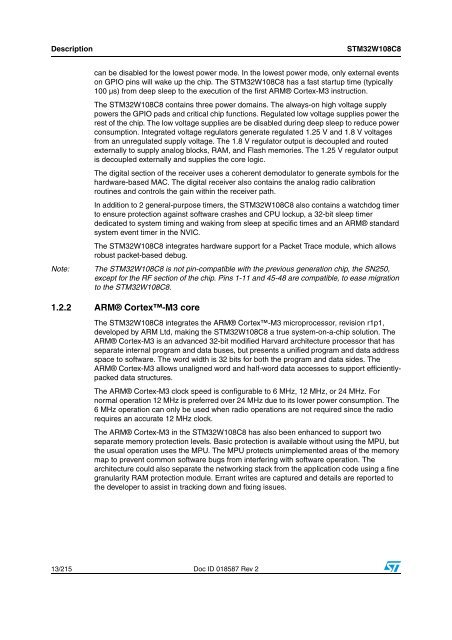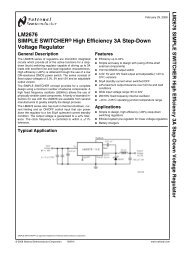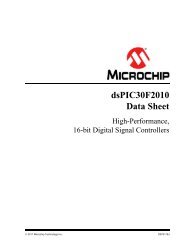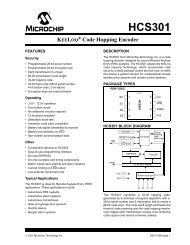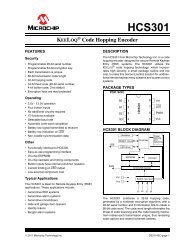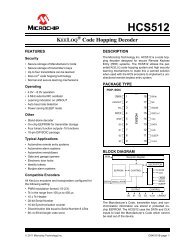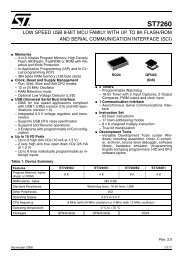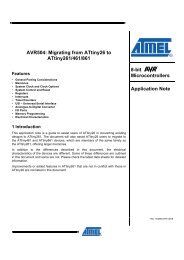You also want an ePaper? Increase the reach of your titles
YUMPU automatically turns print PDFs into web optimized ePapers that Google loves.
Description<br />
<strong>STM32W108C8</strong><br />
Note:<br />
can be disabled for the lowest power mode. In the lowest power mode, only external events<br />
on GPIO pins will wake up the chip. The <strong>STM32W108C8</strong> has a fast startup time (typically<br />
100 µs) from deep sleep to the execution of the first ARM® Cortex-M3 instruction.<br />
The <strong>STM32W108C8</strong> contains three power domains. The always-on high voltage supply<br />
powers the GPIO pads and critical chip functions. Regulated low voltage supplies power the<br />
rest of the chip. The low voltage supplies are be disabled during deep sleep to reduce power<br />
consumption. Integrated voltage regulators generate regulated 1.25 V and 1.8 V voltages<br />
from an unregulated supply voltage. The 1.8 V regulator output is decoupled and routed<br />
externally to supply analog blocks, RAM, and Flash memories. The 1.25 V regulator output<br />
is decoupled externally and supplies the core logic.<br />
The digital section of the receiver uses a coherent demodulator to generate symbols for the<br />
hardware-based MAC. The digital receiver also contains the analog radio calibration<br />
routines and controls the gain within the receiver path.<br />
In addition to 2 general-purpose timers, the <strong>STM32W108C8</strong> also contains a watchdog timer<br />
to ensure protection against software crashes and CPU lockup, a 32-bit sleep timer<br />
dedicated to system timing and waking from sleep at specific times and an ARM® standard<br />
system event timer in the NVIC.<br />
The <strong>STM32W108C8</strong> integrates hardware support for a Packet Trace module, which allows<br />
robust packet-based debug.<br />
The <strong>STM32W108C8</strong> is not pin-compatible with the previous generation chip, the SN250,<br />
except for the RF section of the chip. Pins 1-11 and 45-48 are compatible, to ease migration<br />
to the <strong>STM32W108C8</strong>.<br />
1.2.2 ARM® Cortex-M3 core<br />
The <strong>STM32W108C8</strong> integrates the ARM® Cortex-M3 microprocessor, revision r1p1,<br />
developed by ARM Ltd, making the <strong>STM32W108C8</strong> a true system-on-a-chip solution. The<br />
ARM® Cortex-M3 is an advanced 32-bit modified Harvard architecture processor that has<br />
separate internal program and data buses, but presents a unified program and data address<br />
space to software. The word width is 32 bits for both the program and data sides. The<br />
ARM® Cortex-M3 allows unaligned word and half-word data accesses to support efficientlypacked<br />
data structures.<br />
The ARM® Cortex-M3 clock speed is configurable to 6 MHz, 12 MHz, or 24 MHz. For<br />
normal operation 12 MHz is preferred over 24 MHz due to its lower power consumption. The<br />
6 MHz operation can only be used when radio operations are not required since the radio<br />
requires an accurate 12 MHz clock.<br />
The ARM® Cortex-M3 in the <strong>STM32W108C8</strong> has also been enhanced to support two<br />
separate memory protection levels. Basic protection is available without using the MPU, but<br />
the usual operation uses the MPU. The MPU protects unimplemented areas of the memory<br />
map to prevent common software bugs from interfering with software operation. The<br />
architecture could also separate the networking stack from the application code using a fine<br />
granularity RAM protection module. Errant writes are captured and details are reported to<br />
the developer to assist in tracking down and fixing issues.<br />
13/215 Doc ID 018587 Rev 2


